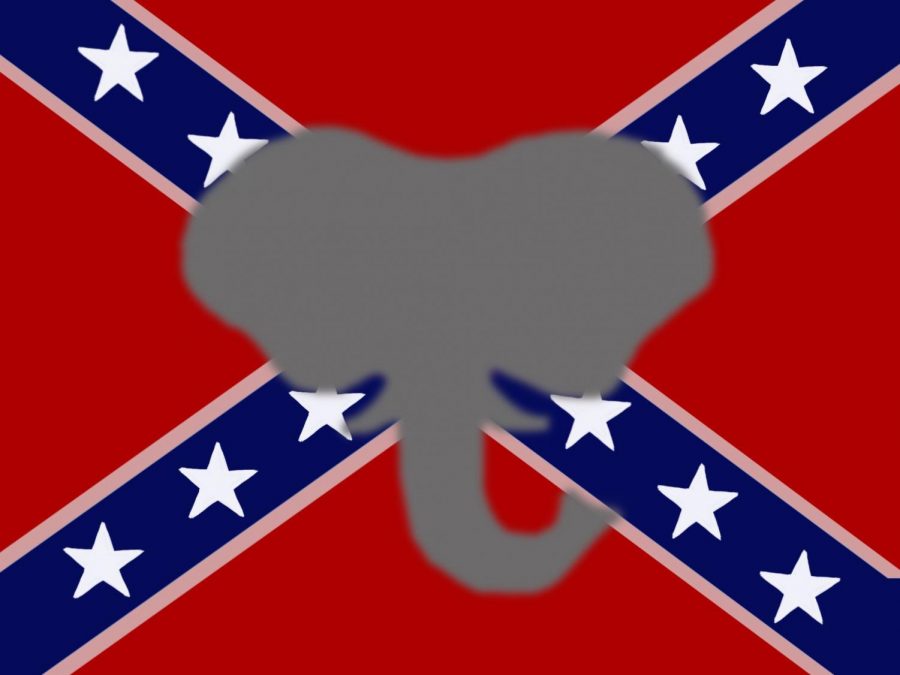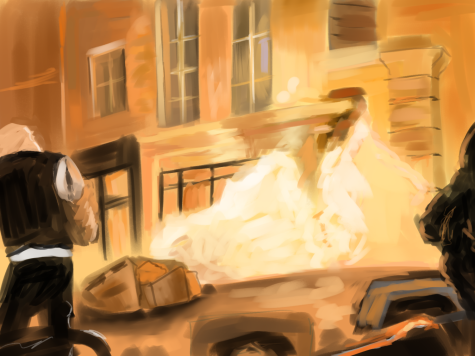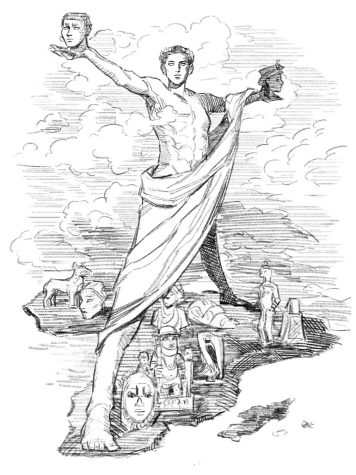The Alt-Right: A Comprehensive History
January 19, 2019
In the current political climate, the term “alt-right” has seen ever-increasing usage. Ask anyone, and they’ll define it loosely as relating to the right-wing end of the political spectrum, with neoconservative ideals and platforms and people such as the Breitbart News Network and Richard Spencer, who first popularized the term in 2010.
But what does it actually mean?
The Associated Press defines it as the term that white nationalists and white supremacists use to describe their demographic and ideology. This ideology includes an emphasis on protecting the white race, in addition to taking traditionally conservative positions on elements of government, including restricted government control, lower taxes, and the strict enforcement of laws. In addition, it is against the idea of multiculturalism, voicing criticisms against rights movements for women, the LGBTQ+, and non-whites, among other American minorities, and the American idea that all should be considered equal, regardless of gender, ethnic origin, or any other metric that might be used to distinguish people from one another.
All told, as the AP summarizes, the alt-right espouses a mixture of racism, white nationalism, and populism.
Although the first known usage of the term “alt-right” was in 2008, the roots of the alt-right movement can be traced to white nationalist groups, such as the Aryan Nations, the National Alliance, and the World Church of the Creator, that have persisted through past decades, despite widespread marginalization by the general public. These groups serve to represent the ideological forebear of today’s alt-right, a resurgence of the ideology that almost puttered out completely in the wake of new mid-2000s anti-terrorism laws after 9/11, under which many prominent leaders of these groups were persecuted.
The ideology received a revitalization when Richard Spencer stepped onto the scene in 2010, popularizing the usage of “alt-right,” although it had already been coined by conservative political philosopher Paul Gottfried in 2008, who described it as a rejection of mainstream conservative ideologies.
Within a couple of years, Spencer was a well-known alt-right political leader, holding multiple important positions, including being leader of the white nationalist think tank the National Policy Institute, and the founder of the “Alternative Right” website. Both his increase in prominence and that of the alt-right movement are partially attributed to the mobilization of the Republican voter base following the first election of President Barack Obama in 2008 and during the midterm elections of 2010, presented by some prominent Republican figures as an opportunity to “take back the country.”
The mobilization of the alt-right intensified especially after the presidential election of 2012, when Democrat President Obama was re-elected to a second term. It was around this time that the alt-right began to grow on the Internet, its followers taking to sites like Reddit, 4chan, Twitter, Gab, and WeSearchr to spread their views, with the last two being hubs exclusively for conservative viewpoints. Such a wide-reaching online community enabled many prominent alt-right figures to gain substantial followings and promote themselves and their merchandise, like Alex Jones, host of the far-right radio show InfoWars, or YouTuber Mike Cernovich.
Soon after, in 2013, this online community received a call to action of sorts in the form of a scandal now known as Gamergate. An independent game designer, Zoe Quinn, had released an interactive game called “Depression Quest,” a depiction of her personal experience with depression. Soon after its publication, a post by one of Quinn’s ex-boyfriends surfaced, accusing her of cheating on multiple men in the gaming journalism industry to get ahead. Despite denials from both Quinn and one of the men named in the posts, the accusations quickly snowballed, resulting in Quinn receiving an extreme amount of graphic death threats, culminating in her fleeing her home and calling police.
Soon after Quinn’s ordeal, people had also begun attacking Anita Sarkeesian, a feminist writer, who had just published another video in an ongoing series on the topic of women and gaming. Not long after that incident, two other women–Jenn Frank, a gaming journalist, and Mattie Brice, a game designer–announced their departure from the industry, following the harassment they had received after writing about Quinn and Sarkeesian. All four women had received extremely graphic death threats, and their harassers had even gone as far as to publish their addresses.
Part of the allure of Gamergate to the online alt-right was the opportunity to champion its ideals–meninist, anti-feminist, neo-Nazi–on sites such as 4chan, Twitter, and 8chan, a spinoff of 4chan created solely for the purpose of discussing Gamergate, supposedly to protest the ethics of gaming journalism.
2013 also saw the launch and growth in popularity of the neo-Nazi Daily Stormer website, which takes its name from the Nazi publication Der Stürmer by Andrew Anglin. The website’s design is reminiscent of 4chan and 8chan, and it covers topics such as anti-Semitism, neo-Nazism, white nationalism, Jewish world control theories, men’s rights, and African-American-on-white crime. It quickly gained traction in 2013, eventually gaining a status as a popular alt-right news source, along with the Breitbart News Network under the leadership of Steve Bannon, although it had been founded by Andrew Breitbart (since deceased, as of 2012) in 2007.
In 2016, the alt-right saw a new figure to follow with the selection of Donald Trump as the Republican presidential nominee when Trump announced that Bannon would become his campaign’s new chief executive. Over the months leading up to the 2016 elections, the alt-right and Trump campaign engaged in a trade-off of sorts–the alt-right embraced the Republican presidential candidate, and Trump did not denounce them, as more center-leaning conservatives and liberals might have.
Both the Trump campaign and his triumphant, fervent cohort of alt-right supporters celebrated his victory over Democratic nominee Hillary Clinton in the elections of 2016. The alt-right finally had a sympathetic official in office–in the Oval Office, no less. This new official shared many of their most polarizing opinions, including being anti-immigration and against political correctness. Emboldened by this new success, members of the alt-right enthusiastically denounced the so-called “multiculturalism” of modern America, as well as America’s perceived deviation from its original intent as a white ethno-state.
Users on these sites often champion the views of conservative politicians and public figures such as Steve Bannon, Sean Hannity, and President Donald Trump, while opposing those of liberal or more centrist politicians and public figures, such as French President Emmanuel Macron, George Soros, John McCain, and Paul Ryan.
2016 was a fairly quiet year for the alt-right. In 2017, the group once again made headlines with the Unite the Right Rally, held by white supremacists in the college town of Charlottesville, Virginia, on August 12 of that year. The trouble had started the day before–a Friday, August 11–on the campus of the University of Virginia. During the evening, a group of white supremacists began a torchlit march through the university grounds; not long after beginning the march, they ran into a group of thirty of the university’s students–both white students and students of color–that had locked arms, blocking their way. The two groups traded insults, punches, kicks, even chemical irritants; both were injured before the police intervened after a block of several minutes.
The next day saw even more chaos, with a tension building between the group of white nationalists and counterprotesters, prior to a march scheduled by the latter. Eventually, law enforcement declared chaotic assembly of the latter group unlawful, and ordered them to disperse. Following the order of dispersal, a member of the white nationalist group drove his van into a group of counterprotesters, killing one–Heather Heyer, a 32-year-old resident of Charlottesville.
Going into 2018, the alt-right has seen decreased attendance at its events, partially attributed to poor organization and to anti-fascist counterprotesters–with counterprotesters even outnumbering alt-right members in some cases. In addition to declining event attendance, the alt-right has also been suffering online, when mainstream social media platforms like Twitter and YouTube have tightened their hate speech policies, banning the views the alt-right espouses. As a result, members of the alt-right have been increasingly confined to smaller platforms that are more tolerant, such as Gab and 4chan.
In the wake of the alt-right’s diminishing influence in mainstream media, some of the notoriety that gave them such clout has begun to vanish. Matthew Maung, ‘21, expresses a viewpoint now held by many–he says, “I don’t care about them as long as they don’t cause any trouble,” but also that “their beliefs are stupid.” Meghan Jin, ‘20, expresses that while the alt-right’s influence may be decreasing, “everyone has the right to express their own political beliefs,” as long as “political groups and people respect one another.”
However, as the world enters 2019, it remains unknown where the alt-right will be headed to next–if it will quietly fade into the background, implode, or make a comeback.
Sources
[1]https://phys.org/news/2017-11-fringe-reddit-4chan-high-alternative.html
[3]https://medium.com/latterly/steve-bannon-the-rise-and-triumph-of-an-alt-right-ideologue-98fa7f25f964
[4]https://contexts.org/articles/the-algorithmic-rise-of-the-alt-right/
[5]https://www.npr.org/2016/08/26/491452721/the-history-of-the-alt-right
[6]https://www.splcenter.org/fighting-hate/extremist-files/individual/andrew-anglin
[9]https://www.wired.com/story/alt-tech-social-media/
[10]https://www.pbs.org/newshour/politics/term-alt-left-came
[11]https://blog.ap.org/behind-the-news/writing-about-the-alt-right
[12]https://www.theatlantic.com/magazine/archive/2017/12/brotherhood-of-losers/544158/
[13]https://www.nytimes.com/2016/08/18/business/media/what-is-breitbart-news.html
[15]https://www.nytimes.com/2016/11/21/us/alt-right-salutes-donald-trump.html
[16]https://www.washingtonpost.com/graphics/2017/local/charlottesville-timeline/?utm_term=.f086a9dd4cd6
[17]https://www.theguardian.com/world/2018/mar/19/the-alt-right-is-in-decline-has-antifa-activism-worked



